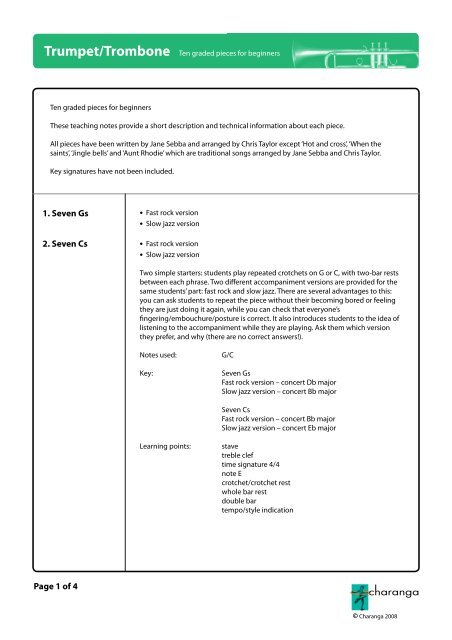Teaching Notes - Charanga Music
Teaching Notes - Charanga Music
Teaching Notes - Charanga Music
You also want an ePaper? Increase the reach of your titles
YUMPU automatically turns print PDFs into web optimized ePapers that Google loves.
Trumpet/Trombone Ten graded pieces for beginners<br />
Ten graded pieces for beginners<br />
These teaching notes provide a short description and technical information about each piece.<br />
All pieces have been written by Jane Sebba and arranged by Chris Taylor except ‘Hot and cross’, ‘When the<br />
saints’, ‘Jingle bells’ and ‘Aunt Rhodie’ which are traditional songs arranged by Jane Sebba and Chris Taylor.<br />
Key signatures have not been included.<br />
1. Seven Gs<br />
2. Seven Cs<br />
Page 1 of 4<br />
• Fast rock version<br />
• Slow jazz version<br />
• Fast rock version<br />
• Slow jazz version<br />
Two simple starters: students play repeated crotchets on G or C, with two-bar rests<br />
between each phrase. Two dierent accompaniment versions are provided for the<br />
same students’ part: fast rock and slow jazz. There are several advantages to this:<br />
you can ask students to repeat the piece without their becoming bored or feeling<br />
they are just doing it again, while you can check that everyone’s<br />
ngering/embouchure/posture is correct. It also introduces students to the idea of<br />
listening to the accompaniment while they are playing. Ask them which version<br />
they prefer, and why (there are no correct answers!).<br />
<strong>Notes</strong> used: G/C<br />
Key: Seven Gs<br />
Fast rock version – concert Db major<br />
Slow jazz version – concert Bb major<br />
Seven Cs<br />
Fast rock version – concert Bb major<br />
Slow jazz version – concert Eb major<br />
Learning points: stave<br />
treble clef<br />
time signature 4/4<br />
note E<br />
crotchet/crotchet rest<br />
whole bar rest<br />
double bar<br />
tempo/style indication<br />
© <strong>Charanga</strong> 2008
Trumpet/Trombone Ten graded pieces for beginners<br />
3. High, low,<br />
earwig oh!<br />
4. Flea y mosquito<br />
5. Edie’s blues<br />
Page 2 of 4<br />
C and G are played in the same piece here, and reinforced as ‘high’ and ‘low’ notes.<br />
The piece gives plenty of repetition of both notes.<br />
<strong>Notes</strong> used: C, G<br />
Key: concert Bb major<br />
Learning points: reinforces crotchet/minim/minim rest<br />
This piece is in three sections: ABA. The A section is almost identical at the start<br />
and at the end. Keep the high split notes short and harsh, as if slapping at the<br />
mossie! Take the opportunity to practise staccato tonguing.<br />
<strong>Notes</strong> used: C, E, G<br />
Key: concert D minor<br />
Learning points: new note E<br />
crotchet rest<br />
dynamics: f, p<br />
high split notes<br />
An easy 12-bar blues using only the notes E and D. Ask students to invent an<br />
alternative last line of lyrics (it must rhyme with blues/news) for further repetitions,<br />
eg He sank six canoes or He’s been on a cruise etc.<br />
<strong>Notes</strong> used: D, E<br />
Key: concert G minor<br />
Learning points: new note D<br />
semibreve<br />
reinforces dynamics f, p<br />
© <strong>Charanga</strong> 2008
Trumpet/Trombone Ten graded pieces for beginners<br />
6. Hot and cross<br />
7. Two-way radio<br />
8. When the saints<br />
Page 3 of 4<br />
A variation on Hot Cross Buns, using dierent rhythm patterns in each<br />
verse/repetition.<br />
<strong>Notes</strong> used: C, D, E<br />
Key: concert Bb major<br />
Learning points: hairpin crescendo<br />
This duet introduces the note F. Dynamics are echoed from part to part. Part 2 is<br />
easier than Part 1: it uses only notes C and F. The pause at the end lasts for seven<br />
beats.<br />
<strong>Notes</strong> used: Part 1 – C, F, G; Part 2 – C, F<br />
Key: concert Eb<br />
Learning points: new note F<br />
dotted minim<br />
pause<br />
reading from two staves<br />
This arrangement of the popular song introduces tied notes and uses all the ve<br />
notes learnt so far: C, D, E, F, G. The tune is played twice, starting the rst time,<br />
and pp the second.<br />
<strong>Notes</strong> used: C, D, E, F, G<br />
Key: concert Bb<br />
Learning points: ties<br />
dynamics: , pp, cresc<br />
© <strong>Charanga</strong> 2008
Trumpet/Trombone Ten graded pieces for beginners<br />
9. Jingle bells<br />
10. Aunt Rhodie<br />
Page 4 of 4<br />
Here’s some more practice at playing the ve notes C, D, E, F, G.<br />
<strong>Notes</strong> used: C, D, E, F, G<br />
Key: concert Bb<br />
Learning points: dotted crotchet/quaver rhythm<br />
dynamics: mf<br />
This traditional song from North America has been given a gory middle section<br />
which reinforces dierent note-lengths (semibreve/minim/crotchet/quavers).<br />
These four bars could be played as an ostinato on untuned percussion throughout<br />
the piece.<br />
<strong>Notes</strong> used: C, D, E, F, G<br />
Key: concert Bb<br />
Learning points: reinforces note values: semibreve, dotted minim, minim,<br />
crotchet, quavers<br />
© <strong>Charanga</strong> 2008









